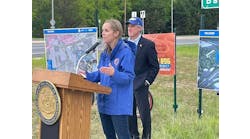By: Jean Snodgress Wiedenheft
As the land steward of a private nonprofit nature center, I maintain 210 acres on a shoestring budget and prioritize ecological restoration in areas that are easily accessible and frequently used by education programs.
Consequently, a small wedge of land—partially under the jurisdiction of the Linn County, Iowa, Secondary Road Department and partially under the jurisdiction of the Indian Creek Nature Center—nestled between the road corridor and the floodplain—received minimal management from anyone.
Through years of neglect the site degraded. Dense vegetation became prolific. The land slopes rapidly downhill away from the road. Along the fifth of a mile of road, oaks and maples, elms and honeysuckles, hackberries and multiflora rose bushes dominate. The bottom of the slope is full of box elders, cottonwoods and mulberry trees. Just to the southeast is a major utility corridor and the Union Pacific railroad tracks. It was a snip of land at the bottom of everyone’s priority list.
A honeysuckle sucking the life
About four years ago, the district forester was visiting and noted that there was a very nice oak savanna trying to survive under the thick layer of invasive honeysuckle bushes along the road. His comments piqued my interest in the site, and the Linn County engineer presented the nature center with a solution to the jurisdictional issue.
The Tree Agreement was only one page. It turned the management of the trees in the right-of-way over to the Indian Creek Nature Center. I agreed to keep all woody vegetation away from the county’s clear zone, 10 ft from the edge of the road and 16 ft in the air. If the county needed to remove a tree because it was an obstruction or posed a hazard, the nature center would be billed for the labor and equipment involved. The contract gave the nature center clear jurisdiction and removed the permitting requirements a landowner typically needs to work in the right-of-way. The county would continue to mow 5 ft from the road edge for motorist visibility. What I did with the trees outside of the clear zone was my business, but the desirable trees could stay.
Suddenly the wedge of land moved higher on my priority list. Led by the vision of the district forester, I went in to investigate what was really there; I didn’t get far. The honeysuckle bushes had been thriving for years. Some had multiple 6-in.-diam. trunks; most had limbs that dwarfed me in height and width and made it impossible to access those main trunks easily. Clearly, removing the shrubs would be a difficult but important first step in making something of the site.
Honeysuckle (Lonicera species) bushes were initially introduced to Iowa from East Asia in the 1800s. There are a number of varieties, but ecologically they all cause the same problems. The disturbed and neglected area along the roadside provides the perfect habitat for the honeysuckle bushes to establish robust populations. Honeysuckles are exceptionally good at forming monocultures, which are ecological disasters.
At first glance honeysuckles are disarmingly pleasant. Hummingbirds and bumblebees drink the nectar. Songbirds eat the berries and nest in the dense tangle of branches. The bushes leaf out early and stay green late into the winter, providing a welcome splash of color against Iowa’s typical winter browns and greys. But underneath the sweet-smelling blooms, more insidious ecological processes are taking place.
Tackling it with teams
Honeysuckle thickets cause wildlife-habitat problems. Birds that require the openness of the prairie or savanna avoid the area. Less desirable birds, like the brown-headed cowbird, increase. But the ultimate problem is in the soil—or the lack thereof. The shrub’s shallow root system allows the soil to wash away from underneath. The result is erosion of the fine sandy loam soil.
The shrubs grow fast and reproduce quickly. This leaves slower-growing woody species, like oak trees, unable to reproduce and thrive. It also prevents sunlight from reaching the ground. The shade prevents plants that would normally be along edges and in an open woodland, such as Ohio spiderwort and windflower, from growing. The honeysuckle roots rob nutrients from the soil, depleting the food supply for other plants.
The honeysuckle’s root system sets it up as an ideal target for physical removal. It is feasible to remove the entire root system, and once removed the shrub stays dead. It seemed like an ideal project to involve volunteers in. For volunteers with little or no restoration work experience, honeysuckle removal is a good introduction: the distinctive bush shape, opposite leaves, light tan bark and hollow stems make identification straightforward.
I began organizing teams to come out. A wedding couple kicked off the project by inviting guests to spend a few hours working on digging bushes prior to the wedding. They allowed plenty of time to shower and change before the main event. A Boy Scout working to achieve the rank of Eagle Scout mobilized his troop and picked up where the wedding guests left off. A local business sent its employees out for a day to finish the project.
The primary tool we used in the war against the honeysuckle bushes was the honeysuckle popper. This consists of a metal pry bar bolted to a wooden hinged fulcrum for leverage. The bar can penetrate the soil directly under a root and lever it out of the soil. There are two obvious advantages of the tool. Digging becomes a very minor part of the project, and the poppers are essentially indestructible.
Having the proper tool does not make it a sweat-free project. The poppers are heavy and have to be worked around the bush. Multiple people are often needed to raise bushes up, attack them from multiple angles or identify points where roots are still embedded in the soil.
The teams ended up breaking four shovels on the project. Shovels are designed to dig; when volunteers used shovels as poppers to lever out a shrub, the shovel handle ended up popping in half. Shovels, though, were key to digging up roots that had snapped and left a significant part underground and for digging up the smallest bushes.
The bushes were piled approximately 30 ft apart throughout the site. The distance was set by the reasonable efficiency of carrying an uprooted bare root bush. The roots, hanging freely in the air from the pile, dry out and die. The piles allow plants to grow unhindered in the rest of the area and provide useful habitat for wildlife as they slowly decompose. They also allow those of us working in the area to continue to do so unhindered by branches on the ground.
After approximately 300 hours of labor during 2008 and 2009, the site looks honeysuckle free. A low-growing canopy of appropriate may apples and wild phlox wildflowers have replaced the honeysuckle bushes on their own. At the surface, seeds from the original bushes continue to germinate and sprout three years later. They are easy to pull by hand after a rain and they are susceptible to fire.
A controlled burn is scheduled for the site during the spring of 2013. Earlier fire attempts were dismal failures. The area was too dark for the oak leaves and other fuel to sufficiently dry out and burn. The bare soil surrounding the honeysuckle bushes did not provide enough fuel continuity for a prescribed burn. As mature plants are no longer setting seed, the honeysuckle presence should continue to fade as the seed bed becomes exhausted.
In 2009 and 2010 I began selectively cutting larger trees from the site to further open the canopy and remove some of the straight-edge effect the roadway corridor has on habitat. Oak trees will continue to be the dominant species close to the road. I removed a number of smaller oaks that if left unchecked would eventually pose a conflict with the right-of-way; removing them early in the growing process allows the surrounding trees to develop healthy growth patterns. Throughout the entire site I focused on removing the fast-growing maples, honey locust, mulberries, box elders, elms, hackberries and dogwoods to allow more sunlight and plant diversity.
The county had planted the ditch immediately adjacent to the road with native prairie plants years ago. The sunlight now available throughout the restoration area will allow seeds from those plantings to migrate, germinate and thrive throughout the site, significantly expanding the diversity of the area. The plant root systems will naturally stabilize the soil, preventing future erosion. R&B
About The Author: Wiedenheft is the land and facility steward for the Indian Creek Nature Center.


